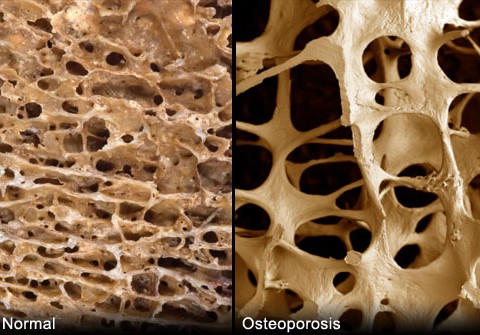Osteoporosis…What Is It?
Osteoporosis is a disease of bones that leads to a decreased density of bone and subsequent increase in risk of fracture. Inosteoporosis, the bone mineral density (BMD) isreduced, bone micro architecture deteriorates, and the amount and variety of proteins in bone are altered.
Osteoporosis…What Is It?
Osteoporosis is a disease of bones that leads to a decreased density of bone and subsequent increase in risk of fracture. Inosteoporosis, the bone mineral density (BMD) isreduced, bone micro architecture deteriorates, and the amount and variety of proteins in bone are altered.
Osteoporosis is a bone weakening disease that has affected millions of people worldwide. The National Osteoporosis Foundation estimates that osteoporosis is a health threat for about 44 million people in the United States alone. The disease is far more prevalent in women than men. According to The National Osteoporosis Foundation, women are four times more likely than men to develop osteoporosis.
Because of these numbers, it is important for women to maintain a healthy lifestyle and diet even in their youth. Exercise and a proper diet for young women can help build strong bone mass for the future to avoid issues (like osteoporosis) later in life. There are recent studies showing that women who drink wine in moderation tend to have higher bone density than those who abstain from alcohol.
Medications Used for Osteoporosis and their Dental Link
Certain osteoporosis medications (also called bisphosphonates) have possibly been linked to osteonecrosis (or “death of bone”) of the jaw. Osteonecrosis is bone death caused by poor blood supply to the area. It is most common in the hip and shoulder, but can affect other large joints such as knee, elbow, wrist, ankle, and jaw. Osteonecrosis is a rare and serious disease that can causes destruction of the jawbone. a condition marked by pain, swelling, infection and exposed bone. The majority of cases of osteonecrosis of the jaw involve people with cancer who have been treated with intravenous bisphosphonates. A number of cases of osteonecrosis of the jaw have been reported in people taking oral bisphosphonates for osteoporosis. These have been primarily associated with active dental disease or a recent dental procedure, such as a tooth extraction.
Osteonecrosis can occur at any age range and can affect a wide range of ethnicity’s. Osteoporosis is considered a very serious disease and is responsible for well over 1.5 million bone fractures per year.
According to the American Dental Association (ADA), osteonecrosis of the jaw linked with osteoporosis medications has mainly been seen in cancer patients who are receiving the bisphosphonates intravenously. In fact, 94% of the cases reported are linked to intravenously-administered bisphosphonates while only 6% are linked with the oral medications.
How Do Bisphosphonates Cause These Bone Issues?
Bisphosphonates are very effective in slowing down the breakdown of bone by targeting the cells which breakdown bone (osteoclasts). An unfortunate side effect is, that they also slow down the bone cells which create new bone (osteoblasts). In areas of the body where the bones do not change much after development, (leg, hip, arm bones), this is not very disruptive. In areas such as the jaw, where bone is constantly reforming and reshaping, the lack of strong bone rebuilding cells is inhibitive to forming new bone after an extraction.
Common Bisphosphonates for Osteoporosis Treatment
-Fosamax
-Boniva
-Actonel
-Didronel
-Skelid
What causes Osteonecrosis?
Osteonecrosis occurs when part of the bone does not get blood and dies. After a while the bone can collapse. If this condition is not treated, the joint will deteriorate and this will become severe arthritis.
Osteonecrosis can be caused by disease, or a severe trauma, that affects the blood supply directly to the bone. Many times, no trauma or disease is present. This is called “idiopathic osteonecrosis” (which means it occurs with no known cause).
Direct Causes of Osteonecrosis:
-Long term use of steroids.
-Abuse of alcohol.
-Sickle Cell Disease.
-Radiation therapy.
-Gaucher Disease. This is a genetic disease in which a fatty substance (lipid) accumulates in cells and certain organs.
Osteoporosis Under Control
-Decompression sickness from a lot of deep sea diving
-Break, Dislocation, fractures around a joint.
Diseases Associated with Osteonecrosis:
-Gout.
-Atherosclerosis.
-Diabetes.
Osteonecrosis Symptoms
-Loosening of teeth.
-Pain in the Jawbone.
-Swelling in the area affected.
-Bone becoming exposed.
-Reoccurring Infection.
Osteoporosis Conclusion
It is good to remember that osteonecrosis of the jaw bone from bisphosphonate medication use is quite rare. The drugs being used to counteract osteoporosis have proven benefits to counteract a very serious disease and reduce bone loss. If you are taking any of the bisphosphonate drugs for osteoporosis call your physician before stopping them. It is also very important to inform your dentist that you are taking such medications so they can have it in their medical history in case something arises during your course of treatment.
Maintain a proper diet, exercise regimen, along with regular visits to your dentist and physician to keep your osteoporosis under control.
© 2012, Marielaina Perrone DDS. All rights reserved. Henderson Cosmetic Dentist
